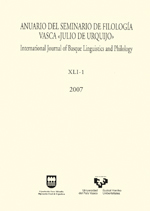Perifrasi zaharra mendebalde eta erdialdeko euskara zaharrean: azterketa kuantifikatiboa eta proposamen berria
##plugins.themes.bootstrap3.article.main##
##plugins.themes.bootstrap3.article.sidebar##
Argitaratua
2007-04-12
Céline Mounole
Laburpena
In the history of the occidental and central dialects of Basque, the verbal periphrases composed by the verbal stem / or the participle and the auxiliaries *edin, *ezan, egin have undergone a change in the form of their principal verb. Up to now, the bascologists have presented this modification as a generalization of the use of the participle within these three periphrases. However, the 15th, 16th, 17th and 18th century texts' data seem to show different tendencies depending on the auxiliaries and the periods. The periphrasis based on the auxiliaries *edin and *ezan have generalized the use of the participle at different times, and the egin auxiliary based one seems to have always employed the participle as its main verb. Thus, these data give us good evidence for proposing that these three periphrases appeared and further grammaticalized on the basis of two different structures: (i) verbal stem + auxiliary (periphrases with the auxiliaries *edin and *ezan), (ii) participle + auxiliary (periphrasis with the auxiliary egin). Furthermore, the [participle + egin] periphrasis has little by little replaced the [verbal stem + *ezan] one in those dialects. In the occidental varieties of Basque this change was accomplished as soon as the 18th century, whereas in the central dialects both transitive constructions still are in complementary distribution.
Nola aipatu
Mounole, Céline. 2007. «Perifrasi Zaharra Mendebalde Eta Erdialdeko Euskara Zaharrean: Azterketa Kuantifikatiboa Eta Proposamen Berria». Anuario Del Seminario De Filología Vasca "Julio De Urquijo" 41 (1):67-137. https://doi.org/10.1387/asju.4311.
##plugins.themes.bootstrap3.article.details##
Zenbakia
Atala
Artikuluak
Lan hau Creative Commons Aitortu-EzKomertziala-LanEratorririkGabe 4.0 Nazioartekoa lizentzia baten mende dago.


